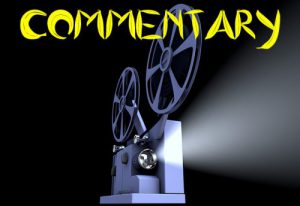Is the killing of a human being ever a cause for celebration? That question came to mind when I saw sports fans celebrating the death of 9/11 terrorist attack mastermind Osama bin Laden on Sunday night during the Mets-Phillies game.
I think we can agree that killing is sometimes necessary for reasons such as self-defense, protection of the citizenry and even for the sake of seeing justice served. But to celebrate bin Laden’s death with cheering and smiling — that seems a bit out of place. Or is it?
This isn’t a news blog, it’s an entertainment blog, so naturally I’m going to turn to “Star Wars” to see what the saga has to say on this issue. It turns out that George Lucas gives mixed messages about the price of war, as if he was never totally comfortable with creating kids’ movies with “Wars” not only in the title, but also as the overarching plot.
In “Episode I,” Lucas skirts around the issues of killing and war, going so far as to break a cardinal rule of filmmaking: He tells, but he doesn’t show. Naboo governor Sio Bibble, speaking about the Trade Federation’s invasion, says “The death toll is catastrophic.” We do see Queen Amidala and members of the royal government being rounded up at gunpoint, but that happens relatively peaceably. If the death toll was catastrophic, there had to be cases where Naboo citizens fought the invading force and were slaughtered; or perhaps they surrendered willingly, but then were murdered in concentration camps.
The title “The Phantom Menace” now takes on a second meaning: The invisible oppressors; evil that happens off screen. And when it comes to showing battles on screen, Lucas makes sure that the bad guys are droids. I don’t think one of our heroes kills a single living-and-breathing bad guy in the whole movie up until Darth Maul. Mostly, Qui-Gon and Obi-Wan mow down droids, and thus the film dodges the gray area that would arise if the heroes killed organic beings on their mission.
“Episode I” ends with a raucous celebration: The Gungan band plays, the queen smiles (for the first time while not disguised as a peasant, I think) and the Gungans and humans formalize their peace treaty. This is shortly after Naboo had been hit with a “catastrophic” death toll, so shouldn’t it have been a more somber occasion? Maybe. But on the other hand, I can understand these people’s desire to move forward into happier times.
Still, there is certainly a disconnect between the horrors of war and the happy celebrations in the “Star Wars” saga, and I’m not the only one who noticed it. The “Return of the Jedi” entry in Seth MacFarlane’s “Family Guy” “Star Wars” trilogy wraps by showing Ewoks finishing off wounded stormtroopers by spearing them in the throat, then the camera pans up to show the happy celebration where everyone — not just the Ewoks, who are admittedly a savage race — is singing and dancing. (The scene works as a spoof of the original ending more so than the Special Edition ending, which has more celebration scenes but also more somber, reflective music.)

And there are other odd examples: Luke loses his best friend, Biggs, in the Death Star battle at the end of “Episode IV.” After he blows up the space station he celebrates back at the docking bay like he just won the Super Bowl. He spares a moment of concern for R2-D2, but not for Biggs, unless that happened off screen.
Again, I’m not going to tell people how they should react after surviving a mission where they almost certainly were going to die. But still, I get a nagging feeling that the movie isn’t acknowledging something, that the tone is slightly off, that Lucas is shifting away from “Wars” and toward “It’s a kids’ movie.”
“Star Wars” isn’t all callousness and avoidance when it comes to the harsh reality of death, of course. In “A New Hope,” Luke is crushed when Obi-Wan is cut down by Vader. In “Return of the Jedi,” he’s sad when Yoda disappears into the Force, and he takes a moment to reflect when watching his father’s funeral pyre. Obi-Wan cries over the body of Qui-Gon, who gets a funeral pyre, too, in “The Phantom Menace.”
And in the case of personal, one-on-one kills, it’s not all fun and games. Luke and his dad don’t dance a jig when Vader throws the Emperor down a shaft in “Jedi.” Anakin seems a bit disturbed after he kills Mace Windu in “Revenge of the Sith.” Later in that movie, Obi-Wan is so distraught after being forced to kill his close friend (“You were my brother, Anakin! I loved you!”) that he doesn’t even finish him off. (Some have interpreted this scene as Obi-Wan not giving Anakin the dignity of delivering a killing blow, but that doesn’t fit with the character we know. So I attribute Obi-Wan leaving Anakin to burn in the lava as a case of him being overwhelmed by the horror of what he had to do.)
Really, breaking down how Obi-Wan reacts to killing Anakin brings us to the question of “What right do we have to judge someone in that situation?”
Still, when I think of characters who deal with the horrors of war in a noble way, I think of Yoda cutting down clone troopers who are attempting to execute Order 66 in “Revenge of the Sith.” The camera zooms in on Yoda’s face, and he looks focused — like any good Jedi in the heart of battle — but also there’s an undercurrent of pain to his expression.
The best example of a freedom fighter visibly acknowledging the cost of war, though, is the “Jedi” scene where the Super Star Destroyer crashes into the Death Star. Cheering voices can be heard in the background, but Admiral Ackbar looks down and then slumps in his seat. It’s as if he’s the only one acknowledging the doomed A-wing pilot who inadvertently started the chain reaction, and also the massive carnage that followed. (As “Clerks” points out, not everyone on the Death Star is an evil Imperial.)
If the way we react to killing an enemy is something that can be judged, then I think Yoda and Ackbar get it right: They do what must be done, but they take no pleasure in the act. There’s something mature and admirable about that.

